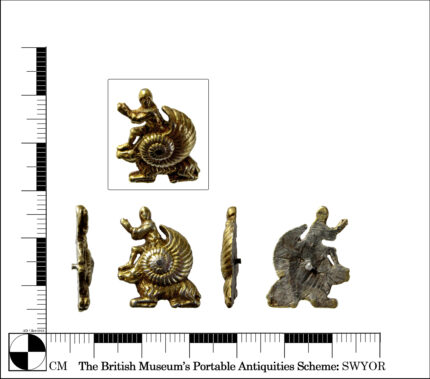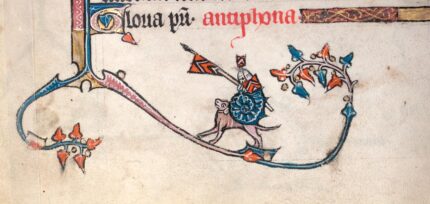A silver-gilt praying knight emerging from a snail shell onto a non-equine quadruped, likely a goat, is one of the stand-out pieces of this year’s British Museum annual treasure report on Portable Antiquities Scheme finds. The object is less than an inch long, has flat back and a short rivet which indicates it was mounted to something thin and rigid like a leather belt. It is solid silver and its shaped and molded front is gilded with some wear on the top of the man’s head on the center of the shell.
It was unearthed by a metal detectorist in a field near Pontefract last September. The mount dates between 1200 and 1350, a time when scenes of knights and snails had a burst of popularity in the art of France, Flanders and England. The motif of a knight in combat against a snail and its many variants were common in the margins of illuminated manuscripts from Arthurian tales to psalters. They weren’t references to anything specific in the text, but rather satirical references to cowardice in a monde renversé (world upside down) style; ie, the little, weak, slow snail treated as a valiant, sometimes even victorious chivalric opponent.
Knights, mounted and on foot, armed to the teeth with swords, lances and bows, charge a snail that faces them with antennae extended. Sometimes a woman begs the knight not to take this terrible risk. Sometimes the knight is on his knees in capitulation before his snail foe. Other variants merge animals and men or feature hybrid animals or animal combatants in place of the knights. The chimeric imagery often evoked snail shell shapes, as in the curled tail of a serpent. The knight-snail-goat has that same elision, where the spirals of the shell are placed where the curled horns of a ram would be.
The Aspremont Psalter-Hours, now in the collection of the National Gallery of Victoria in Australia features a marginal illustration of a knight at arms emerging from a snail shell mounted on the back of a dog. The pose and position of the shell over the animal is comparable to the recently-discovered mount, although the knight in the mount has his hands clasped in prayer, not wielding shield and lance. His Norman style helmet is his only armament.

